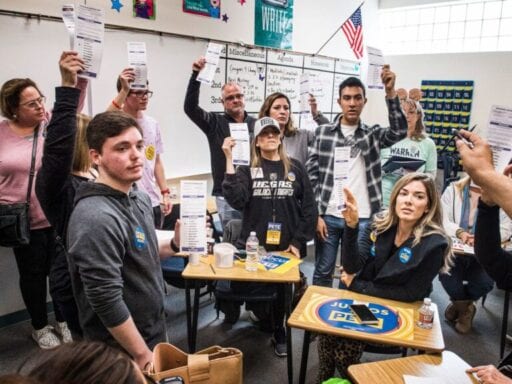Nevada has a very Vegas spin on tie breakers at its caucuses.
Bernie Sanders’s side got the low card, and Pete Buttigieg’s team broke the tie.
At the Nevada caucuses, if two candidates end up with a tie after two rounds of voting, the winner is determined by drawing a card out of a card deck. High card wins, of course.
Accounts from reporters and election workers on the ground indicate that at several of the many caucus sites around the state on Saturday, participants had to resort to cards because of a tie. It’s a Vegas spin on the tie-breaking process that every state has for its elections and caucuses.
Here are the full rules for a Nevada caucus card draw, via Vox’s Andrew Prokop:
- Deck of cards must be shuffled at least seven times by precinct chair or site lead
- Jokers and extra cards removed
- Suit order: spades highest, then hearts, diamonds, clubs
- Aces are high
It appears to have happened several times on Saturday. But even a handful of card draws like this would determine a very, very small number of the delegates that will be won at the caucuses.
Half of the 4 precincts I chaired this morning were determined by cards. Both were small precincts only awarding 1 delegate. #NVCaucus
1 to Pete
1 to Warren pic.twitter.com/P4MydINNfJ— R. Armstrong (@RossEArmstrong) February 22, 2020
Winning a caucus site with a good card draw means winning more county convention delegates, which may ultimately mean the candidate wins more delegates for the 2020 Democratic National Convention. That is the objective of the whole primary: A candidate must win more than half of the nearly 4,000 delegates up for grabs across 50 states and a handful of territories to win the nomination before the convention this summer.
A small number of those delegates are going to be won through card draws, coin flips, and pulling a name out of a hat. At the Iowa caucuses, they would flip a coin; for a three-way tie, they drew a name out of a hat. (Virginia had to pull a name out of a hat because of a tie in a 2017 state legislative race that actually determined control of the state house.)
We saw the card draw again in Reno on Saturday.
Buttigieg beat Sanders at a Reno caucus site by pulling a 3 card. Sanders people pulled a 2. #democracy https://t.co/LP9gGTuYk3
— Colby Itkowitz (@ColbyItkowitz) February 22, 2020
If you want to know exactly the Nevada caucuses are conducted, Prokop has it covered:
It begins when, at each precinct, attendees will divide into groups based on which candidate they support. Then, the first-choice early votes for each candidate will be revealed.
Next, supporters (either in-person or early voters) for any candidate at 15 percent of the vote in each precinct will be locked in — those candidates are officially viable.
But anyone who initially backed a candidate with less than 15 percent of the vote now gets the chance to realign. They can back a viable candidate, combine forces to get a nonviable candidate over the 15 percent threshold, or back no one at all.
Once the in-person realignment concludes, there’s the early vote redistribution. That is: Each early voter whose first-choice candidate ended up nonviable will have their vote moved over to their highest-ranked candidate who is viable.
After this, the final vote total will be tallied in each precinct (combining the realigned in-person vote and the redistributed early vote).
After that is when delegates come in.
Each of the nearly 2,000 precincts in Nevada has been assigned a specific number of county convention delegates, based on how many registered Democratic voters are in the precinct.
So in each precinct, the delegates will be split up among viable candidates proportionally according to the final vote total. Rounding comes into play here, because delegates are people and don’t get split up fractionally. (If there’s a tie, there’s a distinctly Nevadan solution: Cards will be drawn, with the high card determining the winner).
It looks early on caucus day like Sanders will perform strongly in Nevada, probably on his way to an expected victory. But his delegate majority won’t be won at the above caucus site in Reno. You can’t win on a two-card.
Author: Dylan Scott
Read More



